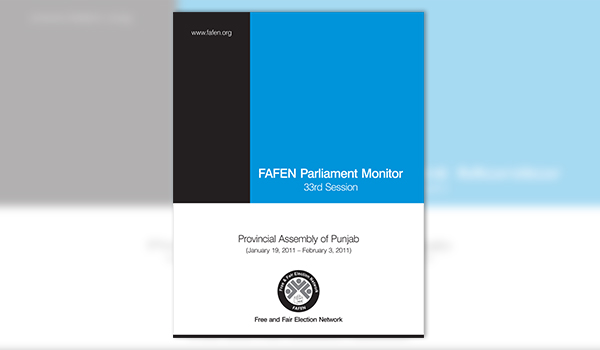 After successfully observing the proceedings of the National Assembly, FAFEN has started observation of the provincial assemblies – Sindh, Punjab, Khyber Pakhtunkhwa and Balochistan – and the Senate. This report is based on FAFEN’s direct observation of the 33rd session of the Punjab Assembly, which was held between January 19 and February 3, 2012.
After successfully observing the proceedings of the National Assembly, FAFEN has started observation of the provincial assemblies – Sindh, Punjab, Khyber Pakhtunkhwa and Balochistan – and the Senate. This report is based on FAFEN’s direct observation of the 33rd session of the Punjab Assembly, which was held between January 19 and February 3, 2012.
The Assembly proceedings are observed using a robust methodology based on the Rules of Procedures and Conduct of Business. The observers collect information on all major types of parliamentary business on a standardized checklist.
The data gathered is analyzed together with that acquired from other parliamentary sources to prepare session-wise reports.
FAFEN has also begun preparing daily factsheets on the Assembly’s proceedings. These are released the same day the sittings are held to provide media and other interested stakeholders vital statistics. The aim is to encourage informed public discourse on Assembly’s performance.
The 33rd session of the Punjab Assembly, the largest legislature in Pakistan with 371 Members, was marked by low attendance. On average only 17 MPAs were present at the start and 37 at the end of each sitting. The session, comprising 11 sittings, lasted 32 hours and 12 minutes – on average each sitting spanning 2 hours and 39 minutes.
All sittings started late; some of them were delayed by more than two hours. The average delay for each sitting was 89 minutes.
The Chief Minister was not present in any of the sittings while the Leader of the Opposition attended five sittings for 225 minutes (13% of the session time). The Speaker chaired nine sittings for 1,173 minutes (66%) and the Deputy Speaker chaired seven for 597 minutes (34%). The Panel of Chairpersons attended all the sittings. The parliamentary leaders of MMAP and PML were present in six sittings each while PMLZ and PMLF leaders did not attend any sitting.
The executive’s oversight function of the Assembly is done through Calling Attention Notices (CANs) and questions.
During the session four CANs appearing on the Orders of the Day were taken up – two were raised by male and as many by female Members. Seventy six out of 328 Starred questions appearing on the agenda were taken up and responded to by the relevant ministries. A total of 193 Supplementary questions were raised.
Speeches by Members and Treasury rejoinders on Points of Order (POs) consumed 22% of the total session time, dipping into the time that was otherwise allocated for agenda items on the Order of the Day. Unless the Chair gives a formal ruling on a Point of Order, speeches and rejoinders do not contribute to any Assembly output and only provide media news pegs. On average 23 minutes of each sitting were consumed by Points of Order.
All Private Members’ Resolutions were adopted by the House. The Resolution on not banning any extracurricular activities in public and private educational institutions was also among those adopted.
The session witnessed five walkouts and two protests. During the 3rd and 5th sittings, the PPPP Members staged a walkout protesting the 27 deaths that occurred due to reaction to drugs supplied by the pharmacy at the Punjab Institute of Cardiology. In the 5th sitting, three PPPP Members and another representing PML walked out against the legislation process followed by the Punjab Assembly. Another two PML Members, during the 6th sitting, walked out to protest the passage of Resolution (on not banning any extracurricular activities in public and private educational institutions) which they claimed had been submitted earlier but not taken up.
Two female Parliamentarians of the PPPP walked out against the harsh language used for women in the House during the 10th sitting. In the same sitting all opposition benches protested against the Minister of Law, Parliamentary Affairs and Public Prosecution and sought apology from him for using unparliamentary words for the opposition. In the 11th sitting, the PPPP Members again walked out against the absence of the Chief Minister.
For complete report click here








